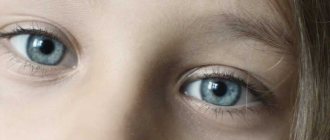If before the birth of a baby parents are only interested in the gender of their future child, then later they are concerned with one question - what kind of eyes the child will have. The pattern chart will fortunately help determine what eye color they can expect. To determine this, knowledge of the school curriculum about recessive and dominant genes is required, but in the modern information world there is no need to spend hours in libraries, covered with a bunch of books about biology. All you have to do is go online and get the corresponding table.
What kind of eyes will the child have - table
Despite the fact that even it will not give one hundred percent accuracy in predicting eye color, this does not stop parents. More details about the genetic connection of eye color between relatives will be discussed in this article.
Eye color - what factors does it depend on?
- 2.1 Video: When a child’s eye color changes and why
- 6.1 Video: What color eyes will the child have?
According to Gregor Mendel's law on the transmission of hereditary characteristics, a child is transmitted from his parents not only appearance or characteristic behavioral traits, but also eye color . This pattern can be explained by the structural features of the iris, or more precisely, by the presence of melanin pigment in it and its quantity. This pigment is also responsible for the appearance of a person’s skin and hair color.

What determines eye color
Note! By studying the color spectrum, scientists have found that blue eyes, due to a small amount of melanin, in most cases are at one pole. And due to the large amount of pigment, brown eyes, accordingly, will be on the other. If we talk about all other colors, they are approximately in the intervals between the previously mentioned poles.
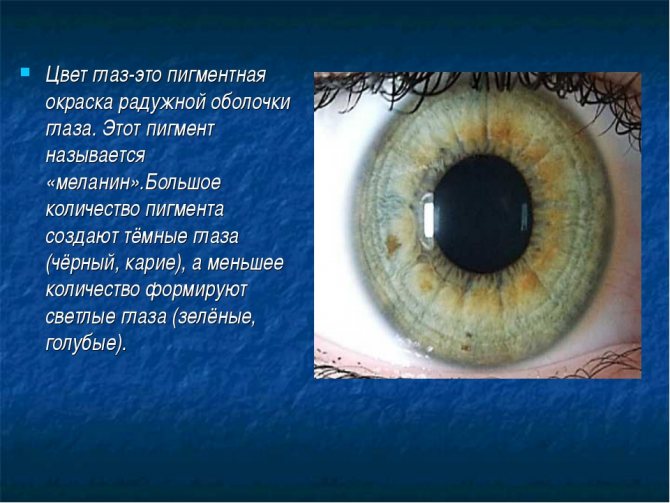
What is eye color
You can predict the eye color of your unborn child using the necessary table and the results of numerous scientific studies, but such information cannot be called absolutely reliable, so parents should not be surprised later that the results of their calculations did not coincide with the appearance of the newborn. According to statistics, 9 out of 10 babies have blue eyes at birth, but over the years the color of the iris may change . This is normal, so if your baby's eyes gradually change color, don't panic.
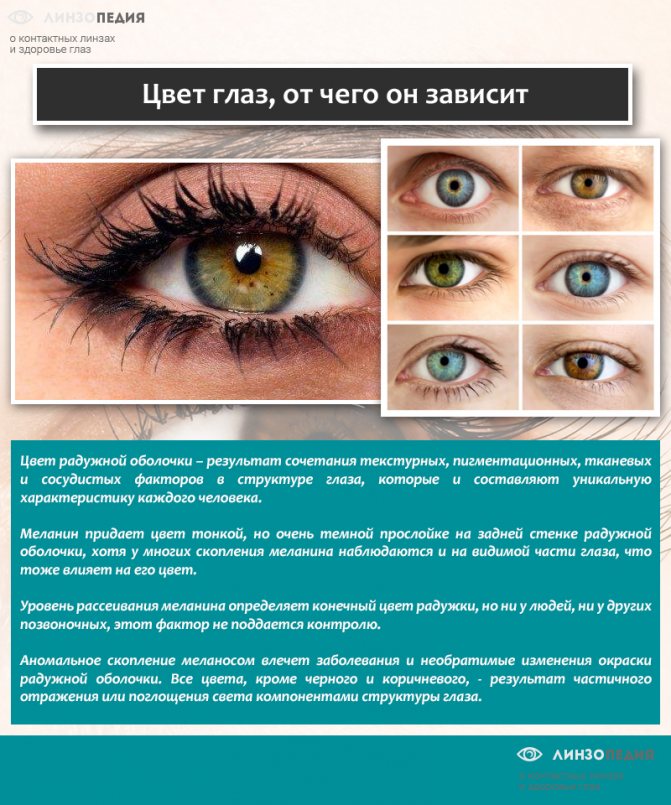
Eye color, what does it depend on?
Age-related changes are associated with the fact that melanin accumulates in the iris on an ongoing basis until the eyes change to a shade determined by genetics. As a rule, such changes are observed as early as 12 months of age, but there may be exceptions. The complete transformation of eye color reaches its final stage, usually at the age of 2 to 3 years, sometimes the process drags on up to 4 years.

Melanin is a special pigment
Video: How to find out the eye color of your unborn child
Reasons for different eye colors in children
Sometimes parents may notice that the baby's irises have a slightly different shade. In this case, we can talk about heterochromia. This phenomenon occurs quite often. One eye is blue and the other is brown. Heterochromia is caused by the fact that one of the irises around the black pupil produces less melanin compared to the other.
Heterochromia is divided into several types:
- Full. The color is fundamentally different.
- Sectoral. One eye has two colors distributed in different proportions across the iris.
- Central. The iris is divided into several rings, each of which has its own color.
If a child has different eyes, this indicates both genetic characteristics and an acquired characteristic. Heterochromia may indicate some diseases, but in most cases it is not caused by pathologies. There have simply been mutations in the genes that are responsible for the amount of melanin in the eye.
Important! Different eye colors can be passed on to offspring provided that the DNA has changed at conception.
If heterochromia is acquired, it can occur due to injury, problems with innervation or inflammation.
Thus, if the baby was born with a different eye color, you should not worry and suspect your soulmate of cheating. It happens. Moreover, a person’s eyes can change even in adulthood. There are known cases when children's irises were gray, and then shifted slightly in color towards green.
What kind of eyes do children have at birth?
The formation of the shade of the moving diaphragm of the baby’s eye occurs in the later stages of pregnancy, but immediately after birth, almost all children explore the world through gray eyes with a slight blue tint. Sometimes newborns have brown or dark, almost black eyes. But, as noted earlier, the original color changes over time, so children do not remain with blue or brown eyes for the rest of their lives.

About the eye color of newborns
If with brown-eyed children everything is quite simple - the formation of their permanent color occurs during the first months - then with other colors of the iris everything is much more complicated. As a rule, children's visual organs can change their color until they are 4-5 years old.
Video: When does a child’s eye color change and why?
On a note! In rare cases (about 1 in 100 children), the eyes are a different shade. This phenomenon is called heterochromia in medicine. This is a rare phenomenon that can be congenital or acquired.
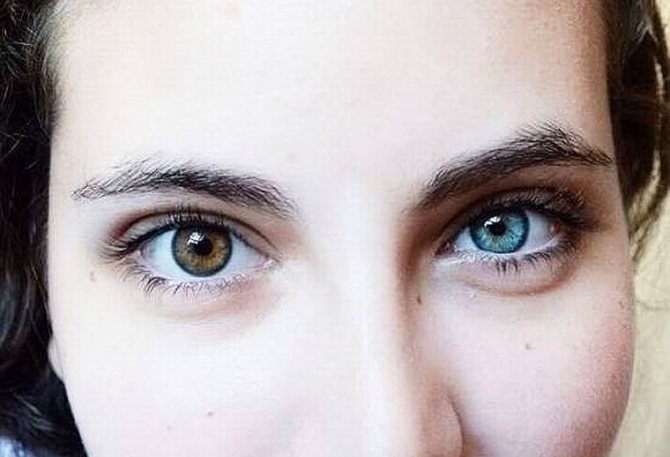
Heterochromia
Many parents wonder why their newborn's eyes are not a consistent color. The answer is quite simple: despite the genetic characteristics of the body, the synthesis of the melanin pigment is activated not while the baby is in the womb, but immediately after birth.

Curious facts about eye color
Why do babies' eyes change color?
The change in eye color is explained by the fact that at birth there is practically no melanin in the iris of the baby's eye. It begins to be produced only after a few days. After the first month of life, the baby's eyes become clear.
The color of the iris depends on heredity and individuality. It should be noted that in the first days of a child’s life it is very difficult to judge the color of the iris.
Visual acuity increases gradually, as the organs of vision synchronize their work with the brain. In the first days of life, the newborn’s brain is not able to process more new information; over time, the baby begins to gradually perceive visual images.
Uncertainty of iris color, cloudiness and lack of coordination
- These are normal conditions of a newborn. How quickly the color of the iris is determined depends on how quickly melanin accumulates. This process is influenced by the baby’s heredity and environment. It should be noted that not only parental genes influence, but also the gene pool of the baby’s ancestors. There are cases when a child's eye color can change several times.
From a genetic point of view
The color of the iris is influenced by certain genes (there are only 6 of them). Of these genes, several are dominant, that is, superior to others. Therefore, superiority will be achieved only by those external differences for which the dominant genes are responsible. There are other genes that are not as strong as the previous ones. Scientists call them recessive. The presence of weak genes, as a rule, does not appear on a person’s appearance.
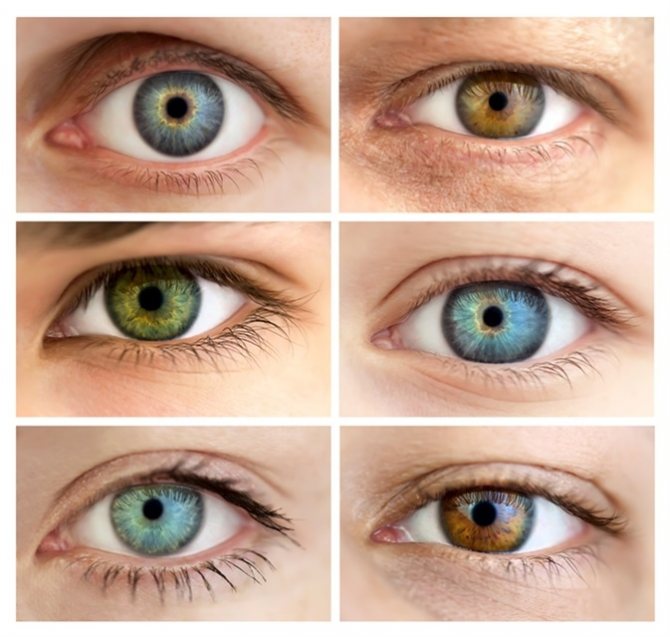
Certain genes influence the color of the iris
Note! Scientists traditionally believe that the genes responsible for the light color of the iris are recessive, and those responsible for darker shades are dominant.
It would be wrong to believe that in a family of parents where both mom and dad have brown eyes, the child will be like them in everything. In fact, everything is much more complicated, because the child copies genes from both the father and the mother at the same time. Each pair copied consists of a recessive and a dominant gene, so the child may end up with different traits from their parents.
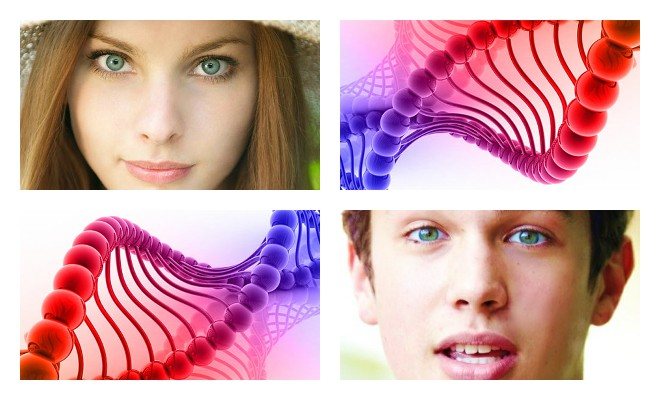
Interesting facts about eye color. Genetics in practice
An external characteristic may not be transmitted by genes immediately, but even after several generations, which is why not only parents, but also grandparents contribute to the formation of the color of the iris. The interaction of genes that are directly involved in the transmission of eye color occurs according to special patterns, thanks to which parents have the opportunity to predict the eye color of the future baby with the highest possible accuracy (more than 90%).
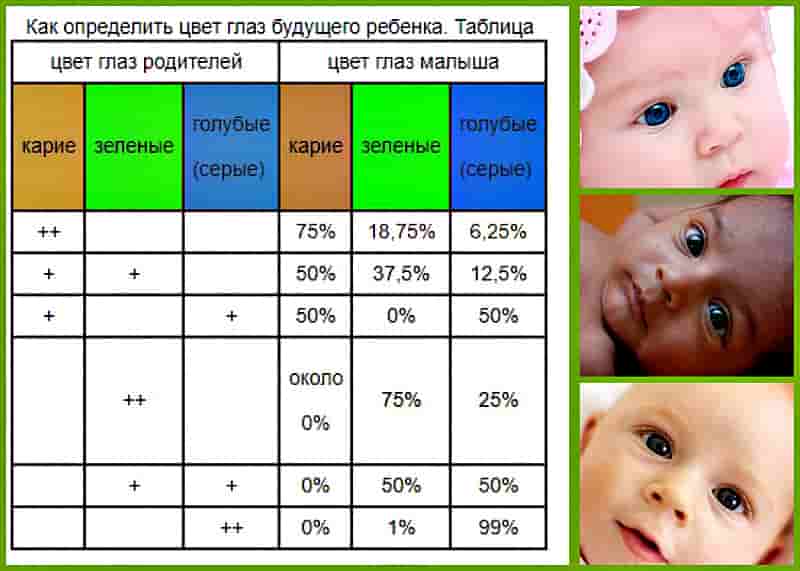
Eye color inheritance table
Who influences a child's eye color?
There are cases when brown-eyed parents give birth to a blue-eyed child. This exception is quite rare, occurring in only 6.25% of children. Why does this happen?
Each person copies two versions of the same gene: from the father and from the mother.
These two versions of the same gene are called alleles. In each pair, some alleles are dominant over others.
In general, brown eye color is dominant (predominant, overwhelming), and most often the lighter one (recessive allele) does not appear in the presence of the dominant one. A recessive allele can appear if it is paired with the same recessive allele.
However, not only parents, but also grandparents can contribute to modeling the child’s appearance. So, if one of the parents still has a hidden recessive allele, then he may well pass it on to the child. Consequently, brown-eyed parents may give birth to a blue-eyed baby, inheriting this trait through a generation. But the opposite situation is unacceptable: a blue-eyed father and mother cannot give birth to a child with brown eyes.
In general, genetics is a complex thing, sometimes it drives us into a dead end. Therefore, you should listen to your heart and trust your loved one, then all sorts of nonsense will not enter your head. After all, it is much more important: whether the child is healthy, and not what color his eyes are!
Will her daughter get her father's rare hair? To get answers to these questions, you can go to the soothsayer Baba Inga or peer into the coffee grounds. However, instead of engaging in shamanism, it’s better to remember your school biology course.
While you exchanged notes with your best friend or counted crows while looking out the window, the teacher patiently explained to you and your classmates what happens when the female and male reproductive cells unite. In the process of merging, a new life is born, which receives part of the paternal and maternal genes, which carry a huge amount of information: they are responsible for the appearance, health, and mental abilities of the unborn child. Despite the fact that the baby receives all the signs from his mother and father, he is born as a completely unique personality, whose exact portrait cannot be drawn by any scientist in the world: no one knows for sure exactly how the genes are intertwined in a bizarre way. However, there are a number of features that can be predicted with a certain degree of probability: for example, what the child’s eye color, hair shade, height, etc. will be.
Eye color layouts
You can determine the color of a child’s eyes, taking into account the characteristic qualities of the parents, using a special table for determining the shade. It was developed by scientists based on statistical research. It is possible that in a dark-eyed family a baby with blue eyes will be born. But how to determine whether their child will be green-eyed or brown-eyed? The table below will help you cope with this.
Table. Determining the color of the iris.
| Mom and Dad's eye color | Baby's eye color (probability percentage) |
| Brown + brown | Brown – 75%, green – 18.75%, blue – 6.25% |
| Green + brown | Brown – 50%, green – 37.5%, blue – 12.5% |
| Blue + brown | Brown – 50%, green – 0%, blue – 50% |
| Green + green | Brown – 0%, green – 75%, blue – 25% |
| Green + blue | Brown – 0%, green – 50%, blue – 50% |
| Blue + light blue | Brown – 0%, green – 1%, blue – 99% |
It must be taken into account that all the above values are conditional, since the definition table does not provide shades (for example, gray-blue). In addition, gray and blue cannot be called the same colors, which only confirms the conventional meaning.

Grey-blue eyes
According to Mendel's law, hair color is also inherited, so parents with blond hair are most likely to have a blond child. But if the hair color of the parents is different, then the child’s hair will be a more neutral color, something in between the parents’. Of course, there may be exceptions to this theory.
What factors influence the change in color of the iris?
The following factors influence eye color in newborns:
- If the baby has produced little melanin in his body, then his eyes will be light. Cloudiness in the baby's eyes disappears within a month after birth; in some cases, this process may take a little longer.
- The dark color of the iris always dominates the light one, so if one of the parents has dark eyes, then most likely the baby will have dark eyes too.
- Hereditary plays a big role in changing eye color
. So, if the parents have dark eyes, then over time melanin will begin to be produced more actively, and the baby’s eyes will also be dark.
Some argue that the color of a baby's iris can change throughout the day.
. This process can be influenced by the baby’s mood, the lighting in the room, and the weather. You should pay attention to the fact that the tone of the iris also depends on blood pressure and the amount of adrenaline received.
It should be emphasized that the color of the baby’s eyes cannot change dramatically.
. Only the shade changes, but not the color. Therefore, if a child was born with light blue eyes, they will not turn brown, but will only change their tone. They can become lighter or darker, it depends on heredity and the amount of melanin produced.
The most common iris color is brown. Second place - series and blue. But the green gene is gradually degenerating and can be found very rarely.
Features of different eye shades:
- gray and blue tones lack pigment;
- a green tint suggests the presence of a small amount of melanin and a pigment such as lipofuscin;
- dark tones are formed due to a large amount of melanin
, which absorbs all light when falling on the iris.
Diseases affecting color
Sometimes eye color is affected not only by genetic factors, but also by the development of certain diseases. For example, hepatitis or jaundice is accompanied by yellowing of the white areas of the organs of vision, which can cause the iris to become darker. Often, even a common cold or illness in children is enough for the organs of vision to become less expressive and their color to become distorted.

Eye color can also change due to disease
Doctors recommend periodic iridology testing. This is a diagnostic event, the essence of which is to study the organs of vision and assess the condition of the iris using modern equipment. Many pathologies provoke a change in the patient’s gaze, as well as cloudiness. At the same time, clean and clear eyes can indicate the child’s good health.

Iridodiagnosis - diagnosis of diseases by modification of the shape, structure, color and mobility of the iris (from the Greek “iris” - “iris”)
There is another disease that affects eye color - albinism. Unlike the previously mentioned heterochromia, albinism is not harmless, because in addition to changing the patient’s appearance, the quality of visual functions also decreases. Albinos often experience phenomena such as eye hypersensitivity and impaired visual perception. The development of albinism is accompanied by discoloration of the iris of the eye, as a result of which it takes on a red tint. This is due to the presence of blood vessels.

Albino
If parents notice that their child’s eyes have acquired an unusual appearance or have changed in color, then they should seek advice from a specialist as soon as possible. Not all diseases that provoke such changes are safe for the patient’s body, so they should not be ignored, especially if we are talking about a small child. But, as practice shows, the development of serious pathologies or anomalies is determined immediately after birth, when an ophthalmologist conducts an examination in a maternity hospital.
What unusual iris colors are there?
If the pigment is completely absent, the iris may be red. This is possible due to the fact that the vessels are visualized in the iris. This phenomenon often occurs in albinos.
Heterochrony is also possible. This is an inherited mutation that causes the eyes to be different colors.
. This deviation does not have any effect on the functions of the visual organs.
In newborns, such an anomaly, the absence of the iris, sometimes occurs. Aniridia can be either complete or partial, and visual acuity is very low. This pathology refers to hereditary disorders.
What diseases can change the color of the iris?
The color of the baby's iris changes:
- with Wilson-Konovalov disease, a copper-colored ring forms around the iris;
- with melanoma or siderosis, the shade of the iris becomes very dark;
- with anemia and leukemia, the baby’s eyes become very light;
- with uveitis, the iris acquires a red tint, as blood stagnates in the vessels
of the visual organs; - in diabetes mellitus, due to the formation of new blood vessels, the iris becomes red-pink.
Please note that the color of the iris in such diseases begins to
, beckon when the disease is at the peak of its development.
To summarize all of the above, the following nuances should be emphasized:
- a change in the shade of a newborn’s eye is a normal phenomenon that is observed in all children;
- often in infants the blue tint of the iris predominates;
- the color of the iris is determined by a genetic factor;
- It is impossible to give an exact answer as to what color the baby’s eyes will be;
- The color of the iris can change up to 5 years.
As a result, it should be noted that changing the shade of a baby’s eyes may take some time. Some people's vision may become clear just a few days after birth, while others will have to wait a little longer. If you notice that the color of your baby's iris has begun to change towards red or yellow, you should immediately consult a doctor, as this may indicate the presence of a disease.
You remember from school that brown is the dominant color. Knowing this, many parents do not think about it when their newborn’s eye color changes. That is, if a child has both mom and dad with dark eyes, he will be brown-eyed. Just like a newborn whose one parent is brown-eyed and the other green-eyed.
That’s why mothers, looking at their baby’s face in the maternity hospital, are surprised: where does he get a blue or purple iris? The thing is that eye colors can change. Why is this happening? When can we expect changes?
Interesting Facts

How eye color in newborns changes with age
Let's look at some interesting facts related to eye color:
- According to statistics, the majority of the population has brown eyes, and the smallest share, 2% of the total number of inhabitants of the planet, falls on green-eyed people. It's also worth noting that most green-eyed babies are born in Iceland or Turkey;
- It is quite difficult to find a person with green eyes in Eastern or Asian countries, but if we talk about people of Caucasian nationality, blue is considered the most common shade there;
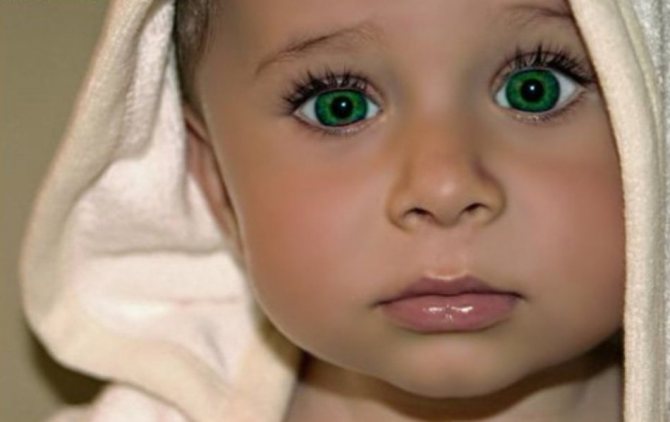
Green eyes are the least common
- Absolutely all newborns are born with blue eyes, but over time the color develops, which, as a rule, is completed by 3-4 years. In rare cases, the final eye color is formed much earlier. This can be explained by the genetic characteristics of the organism;
- Few people know, but brown eyes are blue, which are covered with brown pigment. Thanks to the methods of modern medicine, it is possible to influence the color of the eyes, for example, during surgery it can be changed to blue. But such changes will not be reflected in future offspring;
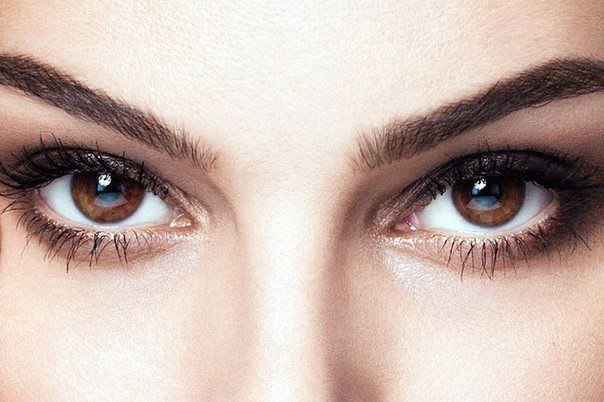
Scientists have proven that blue eye color is hidden under brown pigment in brown-eyed people
- There is a theory among scientists that blue eyes are the result of a genetic mutation, which is why all people with blue eyes share one common ancestor;
- The red color of the iris of the eyes of albinos is caused not by a change in its color, but by its complete absence. The red color itself appears due to the numerous blood vessels in the organs of vision;
- You can find people with yellow or black eyes, but in fact their iris is green or brown, respectively. This phenomenon is caused by improper reflection of the sun's rays entering the eyes.
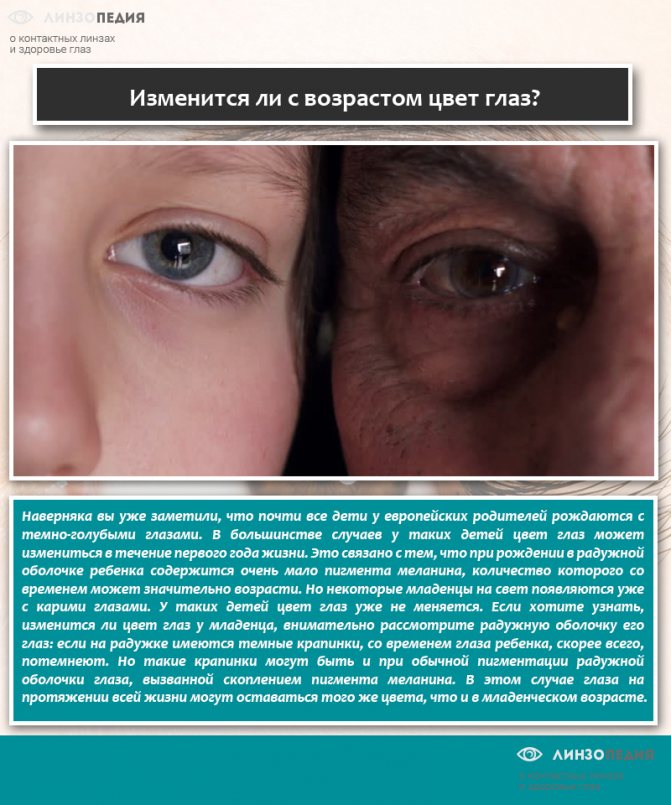
Will eye color change with age?
Using the determination table, you can predict the eye color of your future child with maximum probability. Of course, it is impossible to be absolutely accurate in predictions, because children may initially be born with eyes of different colors.
When and how do babies change eye color?
It is impossible to say unequivocally when parents need to prepare for a change in eye color in their child; everything is very individual. A dark-skinned toddler with brown-eyed parents can delight with a permanent shade already at the age of 2 months. However, it will not necessarily be brown. But still, most often, this process in infants begins at about 6-8 months and drags on for 3-5 years. A later change in color is often observed. In addition, many cases have been recorded in which adult eyes change color depending on lighting and mood.
To give parents peace of mind, pediatricians cite the following facts:
- The process of changing the shade of the iris can happen either quickly or slowly; there is no need to panic, even if this happens at different times for twins.
- For some children, eye color changes several times until it settles. Moreover, the shades can be very different, light and dark.
- The most informative eyes are those of those babies who are initially born with a light blue iris. They are able to change their color several times a day.
With all this, it must be remembered that the likelihood of changes in eye tone and its saturation in newborns or older children may also be due to pathological factors. In cases where the iris is colored unevenly, takes on a bizarre appearance, or the condition is accompanied by changes in the baby’s behavior, the attention of the local pediatrician should be brought to this point.
Parents who are waiting for their baby to change eye color may be interested in the following information:
- The initial and final shades even depend on what country and region the baby was born in. The less sun, the lighter the final version will be.
- Green eyes are found in only 2% of people on the entire planet. Considering the fact that this gene is quite weak, and this amount is gradually but steadily decreasing.
- Among the Russian population, people with gray and blue eyes are most often found; brown eyes account for no more than 30%. Among Belarusians and Ukrainians, brown eyes are found in 50% of cases. Spaniards and Latinos with brown eyes account for up to 80% of the population.
- With physiological (or pathological) jaundice, the sclera of the eyes acquire a yellowish tint, which makes it impossible to accurately determine the child’s original eye color. Only after the condition returns to normal will it become clear what kind of irises the baby has.
It happens that the pigment melanin is absent in the body of a newborn. In this case, his eyes acquire a specific red tint. This condition is called albinism. It does not go away over time and cannot be treated.
The first, but far from the only, surprise greets moms and dads when a newborn baby opens its eyes for the first time. And instead of daddy’s amber shine, everyone sees gray-blue eyes. Has it really been changed?
Our body is amazing, it is formed in utero and after birth throughout life it is constantly changing. There are fewer bones with age, the thymus (responsible for the creation of immune cells) disappears by the age of 15, and even the eye color that we are accustomed to in adulthood could be a different color at birth.
Genetics guarantees a predisposition to the child's eye color depending on the color type of the parents' eyes, but it is impossible to say for sure that your blue-eyed baby will look at the world with light eyes.
This is due to various factors:
- skin color, nationality of parents;
- genetic relationships;
- % melanin content in the body.
Dark-skinned parents with dark eyes cannot give birth to a blue-eyed baby: the dark pigment is dominant in most cases. For light-eyed parents, the process of establishing the color of the baby's eyes is more interesting and less predictable.
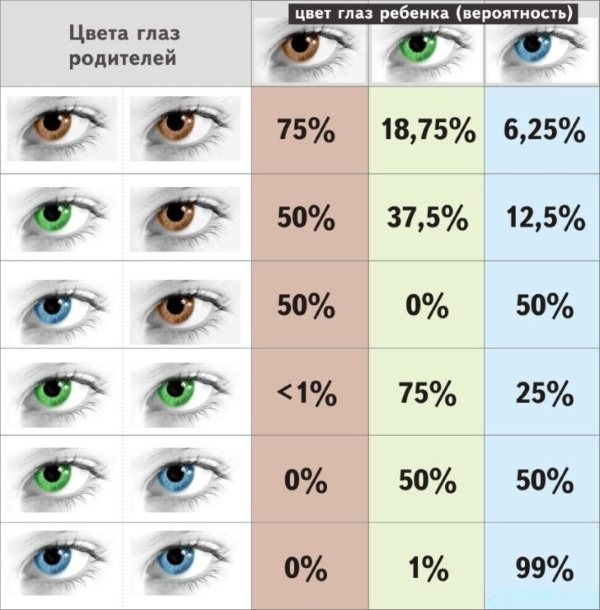
Everything depends not only on the parental genes, but also on the ancestors: it is impossible to predict which dominant gene will be transferred at the moment of conception, and it is also unclear how much pigment a small organism can produce on its own to determine the final color of the eyes.
Subtleties of the process of establishing eye color
Why does a newborn's eye color change? The main reason for the instability of the eye color of a newborn is an increase in the body's production of melanos, melanin (translated from Greek as “black”). This substance:
- consists of high molecular weight compounds;
- responsible for coloring the tissues of living organisms;
- to date has not been fully studied.
We can reliably talk about a direct correlation between eye color and melanin. The higher the pigment content in the body, the darker the baby's eyes will be.
The basis of the iris is made up of textural, pigmentation, tissue and vascular factors in the structure of the eyeball. Melanin colors the thin layer on the back wall of the iris.
The mechanism of its production is activated after birth by special cells - melanocytes. In the first months, the body forms, adapts to the external environment, accumulates pigment, and by six months of the baby’s life, changes in the color of the iris are visible, although the final color tone is established at 2-3 years.
In what cases does a newborn's eye color not change?
In some cases, it is possible to accurately predict the color of a newborn's eyes.
- If both parents are brown-eyed and the child has dark eyes at birth, then they will remain so for life.
Danish scientists conducted a large-scale study and came to the conclusion that initially all the inhabitants of the earth had brown eyes.
- When the parents have a mechanism for disabling the formation of melanin fixed at the genetic level, the baby inherits the factor of “light” eyes, which cannot change with age.
During the course of evolution, a certain mechanism appeared in human genetics that “turns off” the gene that produces melatonin. A decrease in pigment affects the appearance of the entire body, including the eyes. So people with bluish and gray-green eyes gradually began to appear.
Another option when the child’s eye color is stable from birth is albinism. This is a severe form of gene mutations associated with the inability to produce pigment, and then children’s eyes are very light from birth.
Depending on the severity of the disease, they may develop a fear of light and sun, and there is currently no treatment.



